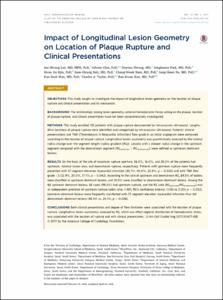KUMEL Repository
1. Journal Papers (연구논문)
1. School of Medicine (의과대학)
Dept. of Internal Medicine (내과학)
Impact of Longitudinal Lesion Geometry on Location of Plaque Rupture and Clinical Presentations
- Affiliated Author(s)
- 남창욱
- Alternative Author(s)
- Nam, Chang Wook
- Journal Title
- JACC. Cardiovascular Imaging
- ISSN
- 1936-878X
- Issued Date
- 2017
- Abstract
- OBJECTIVES This study sought to investigate the impact of longitudinal lesion geometry on the location of plaque
rupture and clinical presentation and its mechanism.
BACKGROUND The relationships among lesion geometry, external hemodynamic forces acting on the plaque, location
of plaque rupture, and clinical presentation have not been comprehensively investigated.
METHODS This study enrolled 125 patients with plaque rupture documented by intravascular ultrasound. Longitudinal
locations of plaque rupture were identified and categorized by intravascular ultrasound. Patients’ clinical
presentations and TIMI (Thrombolysis In Myocardial Infarction) flow grade in an initial angiogram were compared
according to the location of plaque rupture. Longitudinal lesion asymmetry was quantitatively assessed by the luminal
radius change over the segment length (radius gradient [RG]). Lesions with a steeper radius change in the upstream
segment compared with the downstream segment (RGupstream > RGdownstream) were defined as upstream-dominant
lesions.
RESULTS On the basis of the site of maximum rupture aperture, 56.0%, 16.0%, and 28.0% of the patients had
upstream, minimal lumen area, and downstream rupture, respectively. Patients with upstream rupture more frequently
presented with ST-segment elevation myocardial infarction (45.7%, 40.0%, 22.9%; p ¼ 0.030) and with TIMI flow
grade <3 (32.9%, 20.0%, 17.1%; p ¼ 0.042). According to the ratio of upstream and downstream RG, 69.5% of lesions
were classified as upstream-dominant lesions, and 30.5% were classified as downstream-dominant lesions. Among the
66 upstream-dominant lesions, 65 cases (98.5%) had upstream rupture, and the RG ratio (RGupstream/RGdownstream) was
an independent predictor of upstream rupture (odds ratio: 1.481; 95% confidence interval: 1.035 to 2.120; p ¼ 0.032).
Upstream-dominant lesions more frequently manifested with ST-segment elevation myocardial infarction than did
downstream-dominant lesions (48.5% vs. 24.1%; p ¼ 0.026).
CONCLUSIONS Both clinical presentation and degree of flow limitation were associated with the location of plaque
rupture. Longitudinal lesion asymmetry assessed by RG, which can affect regional distribution of hemodynamic stress,
was associated with the location of rupture and with clinical presentation.
- Department
- Dept. of Internal Medicine (내과학)
- Publisher
- School of Medicine
- Citation
- Joo Myung Lee et al. (2017). Impact of Longitudinal Lesion Geometry on Location of Plaque Rupture and Clinical Presentations. JACC. Cardiovascular Imaging, 10(6), 677–688. doi: 10.1016/j.jcmg.2016.04.012
- Type
- Article
- ISSN
- 1936-878X
- Appears in Collections:
- 1. School of Medicine (의과대학) > Dept. of Internal Medicine (내과학)
- 파일 목록
-
-
Download
 oak-2017-0182.pdf
기타 데이터 / 1.17 MB / Adobe PDF
oak-2017-0182.pdf
기타 데이터 / 1.17 MB / Adobe PDF
-
Items in Repository are protected by copyright, with all rights reserved, unless otherwise indicated.